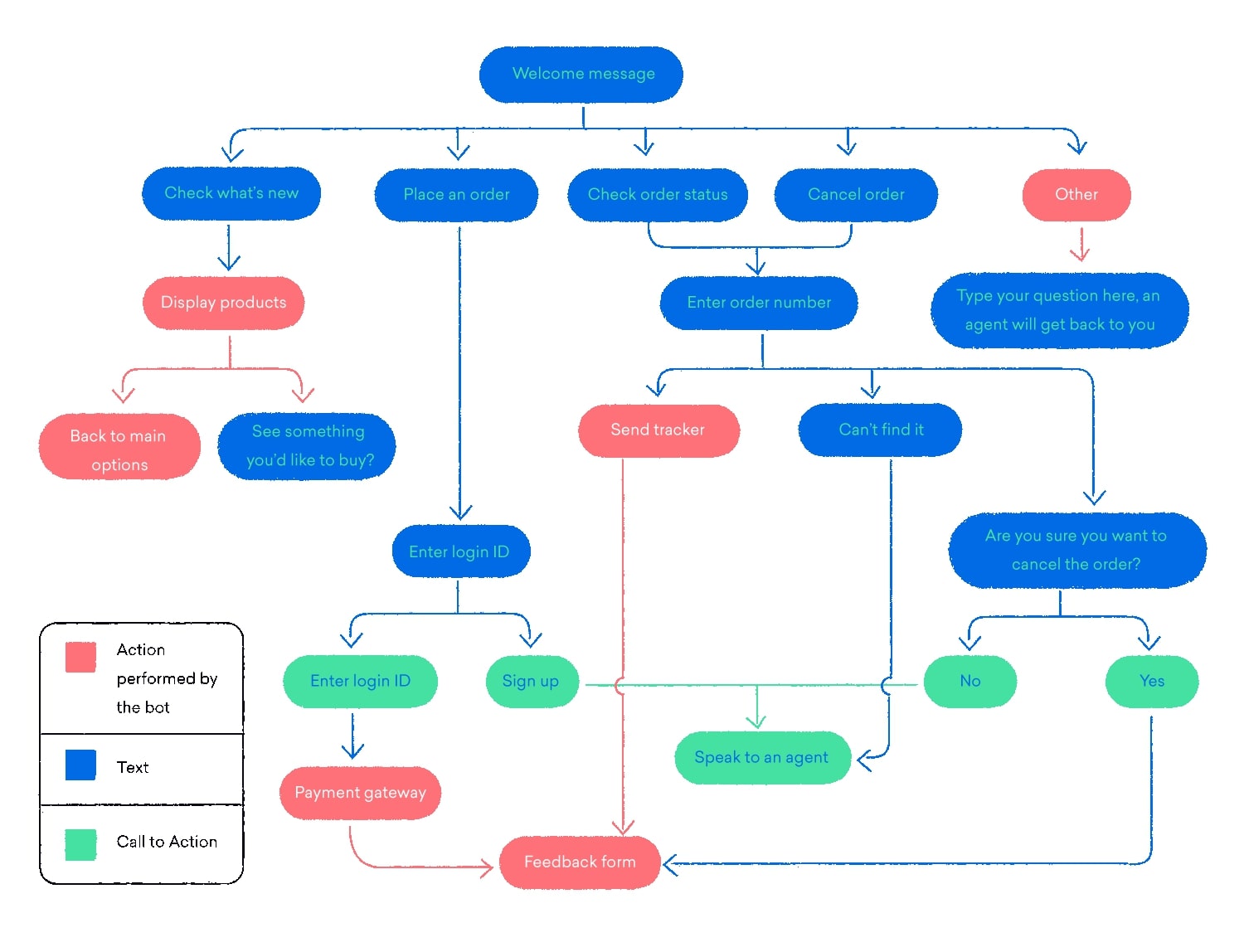How to Create a Conversational Flow That Drives Conversion
Glory-Anna Oshafi
Ever interacted with a chatbot or voice assistant and been impressed by how natural and intuitive the conversation felt? Or you’re wondering how businesses can design a conversational interface that guides the conversation toward a specific goal, such as making a sale or capturing a lead?
Conversational marketing has exploded in popularity in recent years, with more and more businesses leveraging chatbots and voice assistants to engage with customers and drive conversions. A report by Drift shows that about 50.7% of businesses using conversational marketing claim that it enables them to respond to visitor questions more quickly.
But what makes a conversational flow effective?
In this post, we’ll closely explore the power of conversational flow and why it has become such a valuable tool for businesses. We’ll dive into the key components of an effective flow and share best practices for designing a conversation that connects with your audience and leads to conversion.
Get ready to transform how you engage with your customers and unlock the full potential of conversational marketing.

What Is a Conversational Flow?
Conversational flow is the sequence of interactions between a user and a conversational interface, such as a chatbot, voice assistant, or messaging app. The flow is designed to guide the conversation naturally and intuitively to achieve a specific objective, such as answering a customer’s question or completing a transaction.

An effective conversational flow is created to mimic a human conversation, with the interface responding to user input and adapting to their needs and preferences. Essentially, design your conversational flow to engage the user or visitors, provide value, and ultimately lead to your desired outcome, such as a purchase or a lead capture.
Conversational flow is a versatile tool with many applications in various industries. For example, Sephora, the cosmetics retailer, uses a chatbot to provide customers with personalized product recommendations and tutorials.
The conversational flow can ask customers about their preferences, provide makeup tips and tutorials, and guide them toward purchasing. The chatbot can increase conversions and sales by providing personalized support and guidance.
Creating a compelling conversational flow can also improve customer satisfaction, increase conversions, and create a more personalized and engaging user experience.
Further Reading – What Is Conversational Commerce and Why Is It Important?

Learn about conversational commerce and ways to leverage it to convert customer relationships into revenue drivers. Read more now!
How Do You Create a Conversational Flow?
Without a doubt, creating a successful conversational flow requires careful planning and attention to detail. When designing your conversational flow, focus on these steps:
- Define Your Conversational Objectives: You need to determine what you want to achieve through your conversational flow. For example, your objective might be to provide customer support, recommend products, or generate leads.
- Identify Your User Personas: Identifying your target audience and determining their needs and preferences will help you create a more personalized and effective conversational flow.
- Create Your Bot Persona: You can create a persona for your chatbot in line with your brand voice and tone. This is a great way to humanize the chatbot and make it more relatable and approachable to users.
- Map out the Conversation: Creating a visual diagram to map the conversation flow, including all the questions, responses, and possible outcomes, will help you form a clear, structured conversation that guides the user toward the desired result.
- Write Your Conversational Script: Based on the conversation map, write the conversational script, including all the possible responses and actions the chatbot can take. Be sure to keep the tone of the conversation natural and casual.
- Test and Refine: You can test your conversational flow with a group of users, and use their feedback to refine and improve it. Continuously monitor and update the conversational flow as needed to ensure it remains efficient and relevant.
Why Is the Flow of Conversation Important?
In 2019, there were roughly about 3 million virtual assistants in use. By 2024, this number is expected to reach about 8 billion, almost equivalent to the global population.

How is this relevant to your business? In a few years, AI-assisted technology is going to become an integral part of functional businesses as it helps to save cost, time, and human effort. But having a smart bot for your business is not enough.
The better trained it is to interact in a human-like manner, the more likely customers will choose your business over the rest. Check out a few essential reasons conversational flow is so vital for conversion:
- User Experience: Conversational flow can help guide users through interaction in a more natural and intuitive way, leading to a better user experience and greater engagement.
- Personalization: You can tailor your conversational flow to the individual user’s needs and preferences, providing a more personalized experience that increases the likelihood of conversion.
- Efficiency: Conversational flow can help your visitors achieve their desired outcome more quickly and efficiently, improving the customer experience.
- Consistency: A well-designed conversational flow can help ensure that users receive consistent and accurate information, which can help build trust and credibility.
- Insights and Optimization: By analyzing user behavior and conversation data, you can gain insights into what is working well and what needs improvement in the conversational flow. This can help you identify areas for optimization, eventually leading to improvements in user engagement and conversion rates.
- Shorter Sales Cycle: A conversational flow designed to guide users through the sales process naturally and intuitively can help address their questions and concerns, build trust, and ultimately lead to faster conversion.
What Are the 8 Stages of Conversation?
Conversational flow typically consists of several stages that guide the conversation toward a specific goal. For instance, the chatbot’s conversation in the flow diagram below guides the user through various stages until they reach their goal.

The stages of conversation generally include the following:
- Greeting
This is where the chatbot welcomes the user and introduces itself. The greeting should be friendly but professional, setting the conversation’s tone. Remember that the first impression is critical; a positive greeting can help establish trust and credibility.
- Identification
In this stage, the chatbot asks the user for their name or account information to personalize the conversation. Personalization is important because it helps to create a more engaging and compelling dialogue.
- Intent Recognition
Here, the chatbot uses Natural Language Processing (NLP) to understand the user’s intent and determine the reason for their inquiry. The intent recognition stage is vital as it helps ensure the chatbot provides the user with relevant and useful information.
- Information Gathering
In this conversation stage, the chatbot asks the user questions to gather more information about their inquiry. When creating your conversational flow, design the questions to gather relevant information that can be used to provide more personalized recommendations or solutions.
See how Sanuker’s chatbot uses questions to gather the information below:
- Recommendation
This is the stage where the chatbot provides recommendations or solutions based on the information gathered in the information-gathering stage. The chatbot should always be designed to present the solutions clearly and concisely. Also, see the above image.
- Objection Handling
In this conversation stage, the chatbot addresses any objections or concerns the user may have about the recommendations or solutions offered. If successful, the objection handling stage helps to build trust and credibility with the user.
- Closing
The chatbot encourages the user to take action based on the recommendations or solutions offered. The closing stage is where conversions happen.
- Feedback
This is where the chatbot asks the user for feedback on the interaction. The feedback can be in the form of a rating, a comment, or a suggestion for improvement. By gathering feedback, the chatbot can learn from the interaction and improve future conversations with the user.
Key Components of a Successful Conversational Flow in Social Commerce
In the world of social commerce, where interactions with customers are no longer limited to just face-to-face conversations, having a successful conversational flow is essential to achieving your business goals.
The following components are the foundation for building a user-centric, personalized, and contextually relevant conversational flow:
- Personalization and Relevance
Without personalization and relevance, conversational flows can feel generic and impersonal, leading to a less engaging and less effective experience for the user. Personalization allows you to create a more engaging and personalized experience for users by tailoring the conversation to their preferences, behavior, and history.

In the example above, the chatbot made menu recommendations based on the user’s behavior (the comment).
Relevance, conversely, ensures that the conversational flow is contextually relevant to the user’s situation and needs. When you provide relevant and personalized information, you can increase the chances of users engaging with the conversational interface and ultimately purchasing.
- Clarity and Consistency
Clarity ensures that the conversation is easy to understand and that users can follow the flow without confusion. It’s important to use clear and concise language and to avoid jargon or technical terms that users may not understand.
While consistency ensures that the conversation follows a logical and predictable path, this means maintaining a consistent tone and style throughout the conversation and providing consistent and accurate information.
Consistency can also help build trust with users by showing that your business is reliable and can be counted on to provide a consistent and high-quality experience.
- Engagement and Interaction
A conversational flow needs to be engaging and interactive to be effective, keeping users interested and involved in the conversation. This may include using multimedia content, such as images, videos, and GIFs, to make the conversation more visually appealing and interactive.

In addition, encouraging users to interact with the chatbot through questions, prompts, and calls to action can also boost user engagement.
An engaging and interactive conversational flow will encourage users to complete their intended actions, such as making a purchase or providing their contact information.
- Timing and Responsiveness
Timing refers to when the chatbot initiates the conversation with the user, while responsiveness refers to how quickly the chatbot responds to user input.
If the chatbot initiates the conversation too early or frequently, it can be perceived as intrusive or annoying. But if the chatbot initiates the conversation too late, the user may lose interest.
Also, if the chatbot takes too long to respond to user input, the user may become frustrated and disengaged. Hence, optimizing the timing and responsiveness of your conversational flow is necessary to create a more effective and satisfying user experience.
Last Words
Conversational flow has become an indispensable tool for businesses to connect with their customers and enhance sales.
By developing a conversational interface that imitates human dialogue, companies can direct the conversation naturally and intuitively to achieve a specific goal, such as closing a deal or acquiring a lead. A well-crafted conversational flow can heighten the customer experience, drive conversions, and provide valuable insights into user behavior. To design an efficient conversational flow, businesses should define their goals, recognize their user personas, create a bot persona, map out the conversation, compose a conversational script, and consistently test and refine the flow.
With the advent of chatbots and voice assistants, companies that can adeptly use conversational flow will have a competitive edge in the future of customer engagement.
FAQ
A conversational flow is the sequence of interactions between a user and a conversational interface, such as a chatbot, voice assistant, or messaging app. The flow is designed to guide the conversation naturally and intuitively to achieve a specific objective. This may be to answer a customer’s question or complete a transaction.
Conversational flow is important because it’s vital for positioning your brand as human and improves your chances of a faster conversion. It is essential for a great customer experience, improved personalization, efficiency, and consistency. Also, it provides exceptional insight into user behavior and highlights areas that can be optimized for better delivery.
The major components are vital for building a user-centric, personalized, and contextually relevant conversational flow. They include personalization, relevance, clarity, consistency, engagement, interaction, timing, and responsiveness. These components work together, ultimately, to guarantee a purchase from a customer.
Related Article – How to Use Conversational Messaging

Curious about conversational messaging? Find out why it is so important and how to implement it for your business. Read more now!



